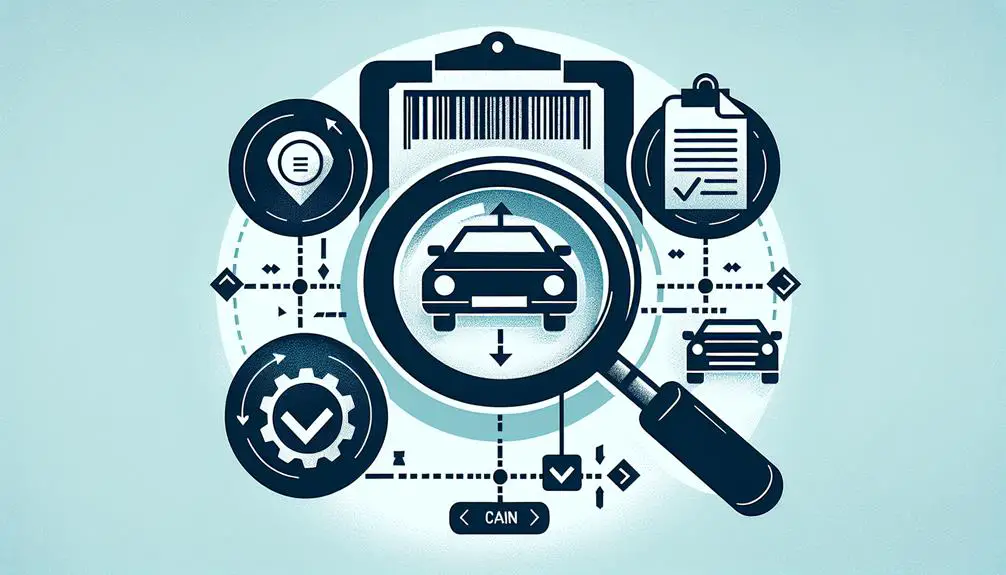To check a car model with its chassis number, locate the number on the vehicle, then use online verification tools or contact the manufacturer directly.
Did you know over 80% of car buyers check a vehicle's history before purchase? Identifying a car model through its chassis number is a pivotal step in this process, ensuring you're making an informed decision.
You'll find your chassis number stamped on the vehicle's frame, often visible through the windshield or inside the door jamb on the driver's side. With a variety of online verification tools and the option to contact manufacturers directly, decoding this set of characters can reveal much about the car's origins and history.
But how can you navigate this process efficiently and what insights can you expect to uncover? Let's discuss what makes the chassis number such a critical piece of information for car enthusiasts and buyers alike.
Understanding Chassis Numbers

A chassis number, often referred to as a vehicle identification number (VIN), is a unique code that serves as your car's distinct identity marker. This 17-character string isn't just a random sequence; it's packed with crucial information about your vehicle. It tells you the car's manufacturer, its year of production, the plant where it was assembled, and even specifics about its model.
You might wonder why you'd need to decode this information. Well, it's incredibly useful, especially when you're looking to buy parts, verify if a car is stolen, or simply learn more about your vehicle's origins. Each character in the VIN has a specific meaning. For instance, the initial three characters, known as the World Manufacturer Identifier (WMI), reveal the vehicle's manufacturer and the country where it was built. The following characters provide details such as the vehicle brand, engine size, and type.
Knowing your car's chassis number isn't just about fulfilling curiosity; it's a practical tool for ensuring you're well-informed about your vehicle. Whether you're troubleshooting, shopping for parts, or evaluating a car's history, this number is your go-to reference.
Locating Your Chassis Number
Finding your car's chassis number is simpler than you might think, and it's essential for accessing specific vehicle information.
First off, check your car's dashboard, on the driver's side. You'll usually find the chassis number displayed there, visible through the windshield. It's one of the most common places manufacturers choose to place this essential identifier. If it's not there, don't worry; there are other spots to check.
Open the driver's side door and look for a sticker or a plate on the doorpost (where the door latches when it's closed). This sticker often contains the chassis number alongside other vehicle details.
If you've had no luck so far, the engine bay is another spot worth checking. The chassis number can sometimes be found engraved on the engine block or on a plate attached to it.
Lastly, your vehicle's registration documents or insurance papers are reliable sources. These documents always include the chassis number, as it's essential for vehicle identification and registration purposes.
Online Verification Tools

Once you've located your chassis number, you can quickly verify your car's details using online verification tools. These platforms are important and offer instant access to a wealth of information about your vehicle. All you need to do is enter your chassis number, and you'll receive specifics about your car's model, make, year, and sometimes even maintenance history.
There are a variety of websites and apps available for this purpose, each with its own database and set of features. Some are free, while others may require a small fee for detailed reports. It's important you select a reputable service to make sure the accuracy of the information provided.
These tools are particularly useful if you're buying a pre-owned car and want to verify the seller's claims about the vehicle's history and specifications. They can also help you find out if the car has been involved in any major accidents, has outstanding finance, or is possibly stolen.
Can I Determine the Model of a Car Using Its Chassis Number?
Yes, you can determine the model of a car using its chassis number. The h2 chassis details contain specific information about the make, model, and year of the vehicle. By decoding the chassis number, you can uncover valuable information about the car’s identity and history.
Contacting Manufacturers
Beyond using online tools, you can reach out directly to car manufacturers with your chassis number for detailed information about your vehicle. This method guarantees you're getting accurate and official data straight from the source. Here's how you can go about it:
- Find the Manufacturer's Contact Information: Look up the official website of your car's manufacturer. They typically have a dedicated customer service section where you can find phone numbers, email addresses, or even live chat options.
- Prepare Your Chassis Number: Before you contact the manufacturer, make sure you have your chassis number handy. This will be crucial for the representative to provide you with the specific details of your car model.
- Be Ready for Verification: The manufacturer might ask for additional information to verify your ownership or to guarantee they're providing information about the right vehicle. This could include your full name, address, or the car's registration details.
Interpreting Results

After obtaining your car's details from the manufacturer, it's crucial to comprehend what those results mean for you. The information provided, typically encompassing the model, year of manufacture, and sometimes even specific features or packages, can greatly influence your vehicle's valuation and insurance premiums. It's not just about knowing the make or model; it's about grasping the full scope of what your car has to offer.
Initially, check the model year and compare it with the car's actual age. Discrepancies here could indicate a mistake or, in rare cases, tampering. Next, examine the details about the car's features. Manufacturers sometimes include information about optional extras that were included at the time of purchase. These could increase the value of your car or explain higher maintenance costs.
To wrap up, don't overlook the importance of this information regarding recalls or manufacturer notices. Knowing your car's exact specifications can help you quickly determine if you're affected by future recalls. Armed with this knowledge, you're in a better position to make informed decisions regarding your vehicle's maintenance, sale, or insurance. Understanding your car's chassis number results empowers you to take full control of your vehicle's journey.
Conclusion
Now that you've learned how to find and interpret your car's chassis number, you're well on your way to revealing its secrets.
Whether you're using online tools, reaching out to the manufacturer, or just curious about your vehicle's background, you've got the know-how to get the information you need.
Remember, your chassis number is the key to a wealth of knowledge about your car, so use it wisely and explore everything your vehicle has to offer.